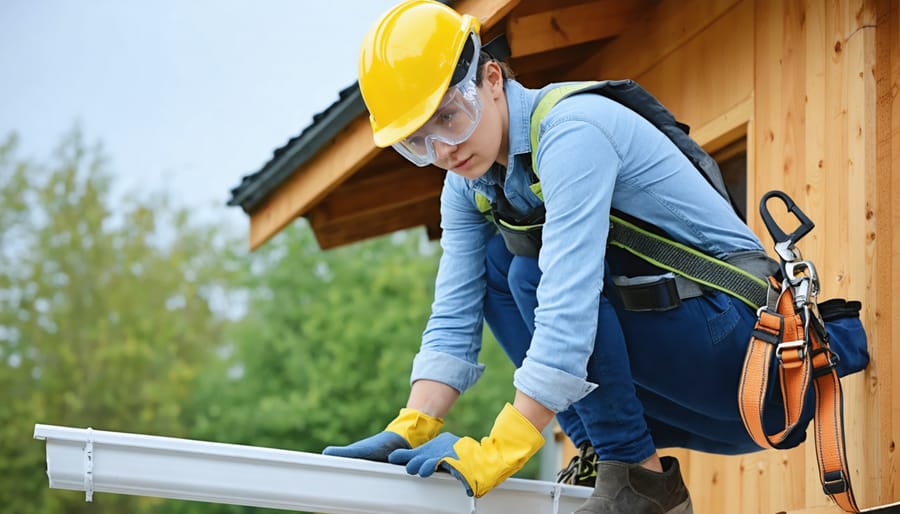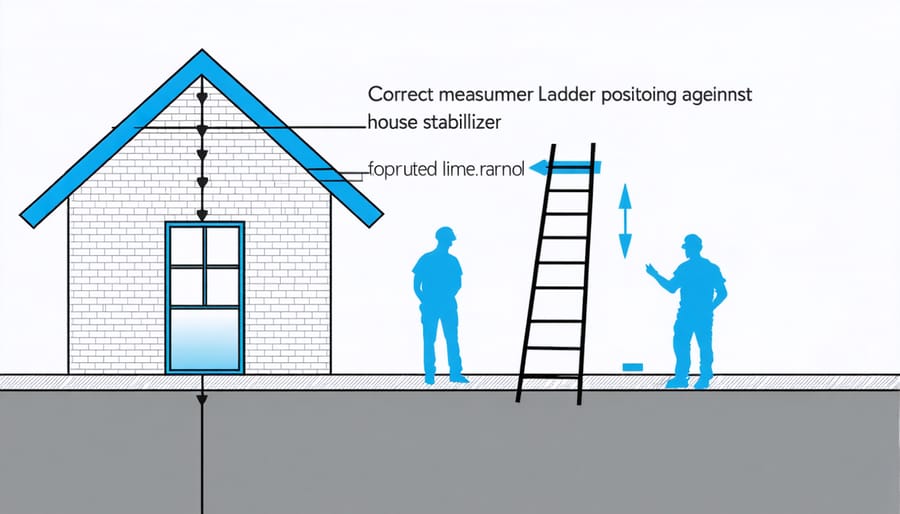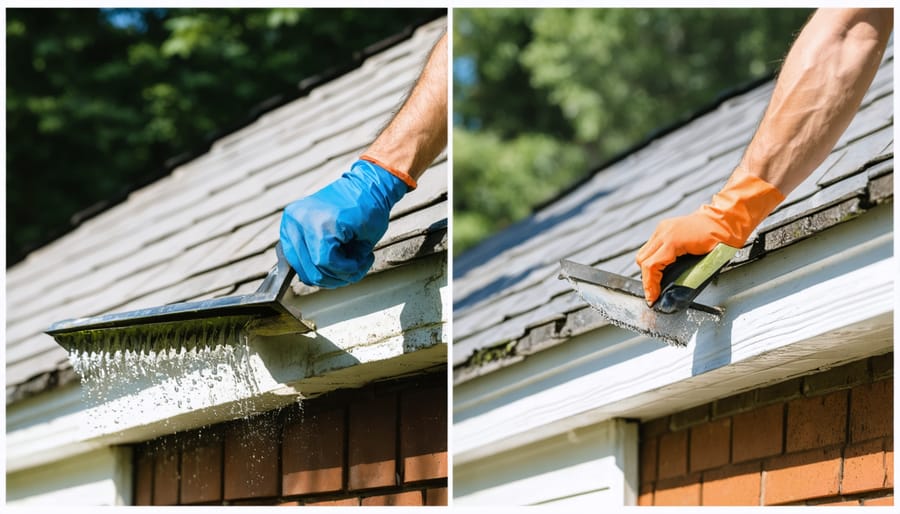Tackle gutter cleaning safely by first inspecting your ladder for stability and positioning it on firm, level ground at a 75-degree angle against your house. Wear thick rubber gloves, non-slip shoes, and safety goggles to protect against debris and potential bacteria. Install ladder stabilizers or standoffs to prevent damage to gutters and maintain a secure distance from the house. Just as you maintain your home’s air quality, keeping gutters clean prevents water damage and foundation issues – but safety must come first. Never work in wet conditions, high winds, or near power lines, and always maintain three points of contact with the ladder while cleaning. Having a spotter on the ground adds an essential layer of safety, especially when working on two-story homes or handling heavy cleaning equipment.
Essential Safety Equipment for Gutter Cleaning
Personal Protection Equipment
Before climbing that ladder, let’s make sure you’re properly equipped for the task. Start with a pair of sturdy rubber or work gloves to protect your hands from sharp debris and potentially harmful substances in your gutters. These should fit well while still allowing good finger dexterity.
Safety goggles or protective eyewear are absolutely essential – they shield your eyes from flying debris, dirt, and splashing water. Choose a pair that fits comfortably and won’t fog up easily during work.
For footwear, opt for non-slip shoes with good traction. Work boots or rubber-soled shoes are ideal, especially when you’re on a ladder or walking on potentially slippery surfaces. Avoid sandals, flip-flops, or any shoes with smooth soles.
Consider wearing a dust mask or respirator to protect against mold spores, dried debris, and other airborne particles. Long sleeves and pants made from durable materials will protect your skin from scratches and sun exposure.
Don’t forget about weather-appropriate gear – if it’s sunny, wear a hat and sunscreen. In cooler weather, ensure your clothing allows for easy movement while keeping you warm.

Ladder Safety Equipment
When it comes to ladder safety, having the right equipment is absolutely essential. A ladder stabilizer or standoff is your best friend during gutter cleaning, as it provides extra stability and keeps your ladder from resting directly against the gutters, which can cause damage. Look for a stabilizer that extends at least 12 inches from each side of your ladder.
Choose a ladder that’s the appropriate height for your home – you’ll want it to extend at least three feet above your roof’s edge. Extension ladders are typically best for two-story homes, while a sturdy step ladder might suffice for single-story buildings. Always opt for ladders rated for your weight plus any equipment you’ll be carrying.
Don’t forget about ladder levelers, which are invaluable when working on uneven ground. These attachments help ensure your ladder remains perfectly vertical, even on slopes. Anti-slip rubber feet are another must-have, particularly when working on smooth surfaces like concrete or tile.
For added security, consider using ladder anchor points or straps to secure the top of your ladder to a stable point on your house. This extra precaution can prevent dangerous lateral movement while you work.
Pre-Cleaning Safety Checklist
Weather and Timing Considerations
Timing your gutter cleaning right can make a huge difference in both safety and effectiveness. The best time to clean your gutters is on a clear, mild day after leaves have fallen but before any rain or snow is forecast. Avoid cleaning gutters during or immediately after rainfall, as wet leaves and debris are heavier and more slippery to handle.
Never attempt to clean gutters in windy conditions, which can make ladder work dangerous and scatter debris. Extreme temperatures are also risky – hot weather can make metal gutters too hot to touch safely, while freezing conditions can create hazardous ice patches on ladders and roofing.
Early to mid-morning is often ideal, as you’ll have good visibility and comfortable temperatures. Try to plan your cleaning when there’s plenty of natural daylight left – avoid working at dusk or dawn when visibility is poor. If your area experiences frequent afternoon storms, schedule your cleaning for the morning hours.
Consider seasonal timing too. While fall is the most common time for gutter cleaning, checking them in spring helps remove winter debris and prepare for spring rains.
Property Assessment
Before starting any gutter cleaning work, it’s crucial to thoroughly assess your property for potential hazards. Begin by scanning the area for overhead power lines, which pose a serious electrocution risk when using metal ladders or tools. Keep all equipment at least 10 feet away from any electrical lines.
Next, examine your working area’s ground conditions. Look for uneven surfaces, soft soil, or hidden holes that could destabilize your ladder. Ensure you have a solid, level foundation for safe working at height. Check for any landscaping features, like rocks or garden beds, that might interfere with ladder placement.
Inspect your gutters from the ground first, looking for visible damage or sagging sections that could indicate structural weakness. Also, note the location of any wasp nests, bird nests, or signs of pest infestation that might require professional attention.
Consider weather conditions too. Avoid cleaning gutters on windy days or when rain is forecast. Morning dew can make surfaces slippery, so plan your cleaning for when surfaces are dry and visibility is good. If you spot any concerning issues during your assessment, it’s always better to contact a professional rather than risk your safety.

Safe Ladder Usage Techniques
Your ladder is your most important safety tool when cleaning gutters, so let’s make sure you’re using it correctly. Start by placing your ladder on firm, level ground – never on soft soil or uneven surfaces. Position it at a proper angle by following the 4:1 ratio rule: for every 4 feet of height, the ladder’s base should be 1 foot away from the wall.
Before climbing, ensure all ladder locks are engaged and the feet are secure. If you’re working on softer ground, use ladder stabilizer plates to prevent sinking. For added stability, especially on taller homes, consider installing ladder stabilizer arms that attach to the top of the ladder and rest against the wall.
Always maintain three points of contact while on the ladder – that means either two hands and one foot, or two feet and one hand should be touching the ladder at all times. Keep your body centered between the rails and never overreach – a good rule of thumb is that your belt buckle should never extend beyond the ladder’s side rails.
Move your ladder frequently rather than stretching to reach distant spots. While it might seem time-consuming, repositioning your ladder every few feet is much safer than overextending yourself. Avoid climbing above the third rung from the top on an extension ladder, or the second-highest step on a stepladder.
Finally, never use your ladder in windy conditions or during rain – wet rungs can be extremely slippery. If you feel unstable at any point, slowly climb down and reposition your ladder. Remember, taking a few extra minutes to ensure proper ladder placement could prevent a serious accident.
Safe Cleaning Methods
Now that you’re properly equipped, let’s focus on the safest and most effective cleaning techniques. Start by removing large debris with a plastic scoop or trowel, working in small sections of 3-4 feet at a time. Always push debris away from your downspouts to prevent clogging, and maintain a stable position on your ladder by keeping your hips between the side rails.
For stubborn debris, use a garden hose with a spray nozzle attachment to flush the gutters. Work from the far end toward the downspout, ensuring water flows freely. If you notice poor drainage, this might also affect proper attic ventilation, so pay special attention to maintaining clear channels.
Never reach more than an arm’s length away while cleaning – instead, climb down and reposition your ladder. Use a bucket with a wire hook for collecting debris, and consider employing a gutter scoop with an extended handle to reduce reaching. For two-story homes, telescoping tools can help you reach higher gutters more safely.
Remember these essential techniques:
– Clean on dry, clear days for better visibility and grip
– Work with both hands whenever possible
– Move methodically from one section to the next
– Check downspouts for blockages using your hose
– Remove debris from the ground immediately to prevent slip hazards
If you encounter any damaged gutter sections or suspect structural issues, mark the location and address these problems separately. Don’t attempt repairs while cleaning, as this can compromise your safety position on the ladder.

Emergency Prevention and Response
Before starting any gutter cleaning work, always inform someone about your plans and keep a fully charged phone in your pocket. Create a safety zone below your work area by placing warning signs or cones to alert others. Check weather forecasts to avoid working in wet, windy, or stormy conditions.
If you encounter a medical emergency while on the ladder, stay calm and call 911 immediately. For minor injuries, carefully descend the ladder and seek appropriate medical attention. Keep a basic first-aid kit easily accessible in your work area.
Should you discover damaged electrical lines near your gutters, stop work immediately and contact a professional electrician. Never touch electrical wires, even if they appear inactive. If you encounter a wasp nest or other pest infestation, slowly back away and contact pest control experts.
In case of ladder instability or if you feel unsafe at any point, don’t push through. Carefully climb down and reassess your setup. Remember, it’s better to pause and adjust your approach than risk injury. Consider hiring a professional if you’re uncomfortable with any aspect of the job.
Maintaining clean gutters is essential for your home’s well-being, but your safety should always come first. Remember to inspect your equipment thoroughly, wear appropriate safety gear, and maintain three points of contact on your ladder at all times. If you’re uncomfortable with heights, unsure about your physical capabilities, or face challenging conditions like steep roofs or multiple stories, don’t hesitate to call a professional. The cost of professional gutter cleaning is a small price to pay compared to the potential risks of injury. By following these safety guidelines and knowing when to step back, you can ensure your gutters stay clean while keeping yourself out of harm’s way. After all, effective home maintenance isn’t just about getting the job done – it’s about getting it done safely and sustainably.
